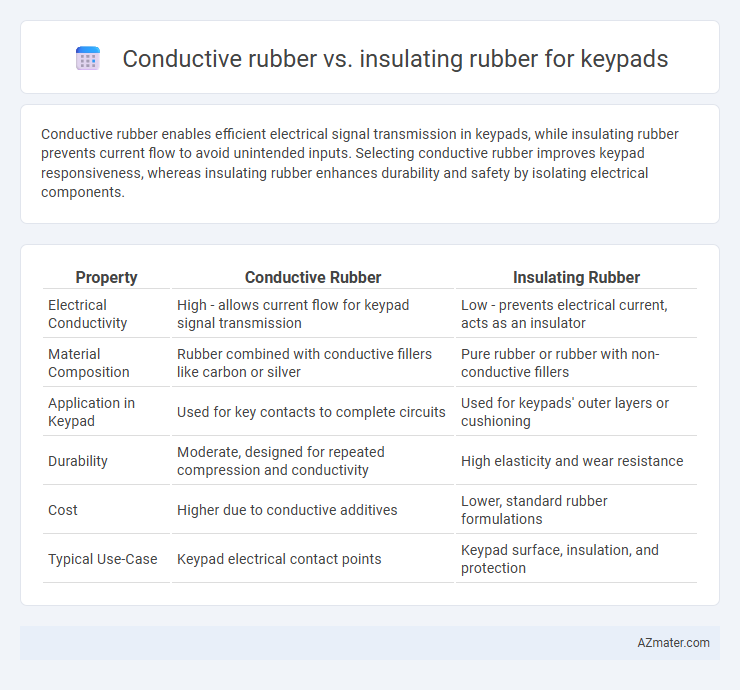Conductive rubber enables efficient electrical signal transmission in keypads, while insulating rubber prevents current flow to avoid unintended inputs. Selecting conductive rubber improves keypad responsiveness, whereas insulating rubber enhances durability and safety by isolating electrical components.
Table of Comparison
| Property | Conductive Rubber | Insulating Rubber |
|---|---|---|
| Electrical Conductivity | High - allows current flow for keypad signal transmission | Low - prevents electrical current, acts as an insulator |
| Material Composition | Rubber combined with conductive fillers like carbon or silver | Pure rubber or rubber with non-conductive fillers |
| Application in Keypad | Used for key contacts to complete circuits | Used for keypads' outer layers or cushioning |
| Durability | Moderate, designed for repeated compression and conductivity | High elasticity and wear resistance |
| Cost | Higher due to conductive additives | Lower, standard rubber formulations |
| Typical Use-Case | Keypad electrical contact points | Keypad surface, insulation, and protection |
Introduction to Keypad Rubber Materials
Keypad rubber materials are critical for determining the functionality and durability of electronic devices, with conductive rubber enabling electrical signal transmission and insulating rubber providing necessary isolation between components. Conductive rubber incorporates carbon or metal particles to allow current flow, making it ideal for contact points in keypads. In contrast, insulating rubber ensures non-conductive regions to prevent short circuits and enhance user safety, emphasizing the importance of material selection in keypad design.
Overview of Conductive Rubber
Conductive rubber used in keypads is composed of silicone rubber embedded with conductive particles such as carbon or silver, enabling electrical conductivity and reliable signal transmission when pressed. This material offers excellent flexibility, durability, and resistance to environmental factors, making it ideal for responsive and long-lasting keypad performance. In contrast, insulating rubber lacks conductive properties and is primarily used for protective or structural components rather than for active key-switching functions.
Overview of Insulating Rubber
Insulating rubber used in keypads offers excellent electrical resistance, preventing unintended current flow and enhancing user safety. Its non-conductive properties make it ideal for isolating electronic components while providing durability and flexibility under repeated keystrokes. Common materials include silicone and EPDM, which ensure long-lasting performance in various environmental conditions.
Material Composition and Properties
Conductive rubber used in keypads typically contains carbon or metal particles dispersed within an elastomer matrix, enabling electrical conductivity for signal transmission. Insulating rubber, made from pure silicone or other non-conductive polymers, provides excellent dielectric properties to prevent unwanted electrical flow and enhance user safety. The distinct material compositions directly influence their properties: conductive rubber offers low electrical resistance and flexibility, while insulating rubber excels in durability, chemical resistance, and electrical insulation.
Electrical Performance Comparison
Conductive rubber for keypads offers low electrical resistance, enabling reliable signal transmission and faster response times compared to insulating rubber, which prevents current flow and acts as an electrical barrier. The electrical performance of conductive rubber is characterized by stable conductivity under compression and minimal contact resistance, essential for accurate switch activation. Insulating rubber, on the other hand, is used to prevent short circuits and protect internal components but does not support electrical conduction necessary for keypad functionality.
Applications in Keypad Design
Conductive rubber is essential in keypad design for enabling electrical contact and signal transmission, widely used in membrane and silicone keypads to ensure reliable button responses. Insulating rubber serves to prevent unintended electrical connections, providing durable separation between conductive layers and enhancing keypad longevity in devices exposed to moisture or dust. Selecting between conductive and insulating rubber materials directly impacts keypad accuracy, tactile feedback, and device durability across consumer electronics, industrial controls, and medical equipment applications.
Durability and Longevity
Conductive rubber used in keypads typically offers enhanced durability due to its ability to maintain consistent electrical conductivity under repetitive pressing and environmental stress. Insulating rubber excels in longevity by providing superior resistance to wear, moisture, and temperature variations, which helps prevent degradation of the keypad structure over time. Selecting between conductive and insulating rubber depends on balancing the need for reliable electrical performance with the importance of physical resilience in specific application environments.
Manufacturing and Cost Factors
Conductive rubber used in keypads contains carbon or metal particles that enable electrical conductivity, making its manufacturing process more complex and costly due to precise material blending and quality control requirements. Insulating rubber, typically silicone or urethane without conductive fillers, offers simpler manufacturing with lower raw material costs and easier molding processes. The cost difference largely stems from conductive rubber's specialized formulation and testing, whereas insulating rubber benefits from mass production efficiencies and fewer material constraints.
Advantages and Disadvantages
Conductive rubber used in keypads offers excellent electrical conductivity and responsiveness, making it ideal for reliable contact and fast signal transmission, but it tends to be more expensive and less durable under constant mechanical stress. Insulating rubber, on the other hand, provides superior resistance to environmental factors such as moisture and dust, enhancing keypad longevity and preventing short circuits, yet it requires additional conductive elements to function effectively in electrical circuits. Choosing between conductive and insulating rubber depends on balancing the need for electrical performance with durability and environmental resistance in keypad applications.
Choosing the Right Rubber for Keypads
Choosing the right rubber for keypads hinges on balancing conductivity and insulation properties to ensure optimal performance. Conductive rubber, embedded with carbon or metal particles, enables electrical signal transmission essential for responsive keypress detection in electronic devices. Insulating rubber prevents unintended electrical contact, making it ideal for separating conductive paths and enhancing user safety in keypad assemblies.

Infographic: Conductive rubber vs Insulating rubber for Keypad
 azmater.com
azmater.com